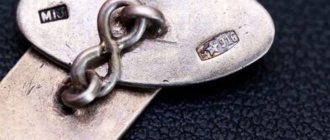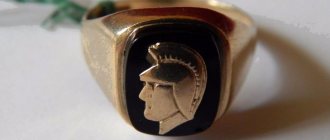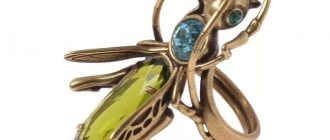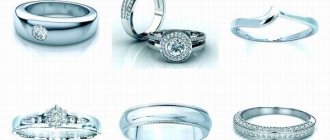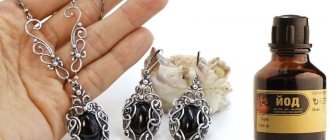Anyone who has purchased products made of precious metals at least once is familiar with the concept of “fineness”. These are several numbers that are written in the “passport” of the product and are available on it itself in the form of an imprint.
But the samples are not the same. For example, gold can be marked with numbers such as 958, 750 and, of course, 585. The last standard is the most popular, since the prices for products with it are an order of magnitude lower than with others. But what do these numbers mean? After all, the metal on which they are applied seems to be the same.
What does the digital code on the product mean?
In fact, there are no pure gold items in jewelry store windows. Everything that glitters beautifully under glass and is quite expensive is made from alloys.
Fineness means how large the “gold component” is in the product. In other words, the jewelry with the digital code 585 contains almost 59% pure gold, and the rest is completely different metals.
Features of the sample and composition
When we talk about 999-carat gold, we undoubtedly mean pure precious metal. The presence of 0.1% master alloy in the alloy does not significantly affect the characteristics of the alloy.
Did you know that 999 gold is also called red gold.
The main characteristics of the sample are:
- extreme softness;
- increased susceptibility to damage;
- slight fusibility and others.
Due to these characteristic features, 999 gold is a universal investment instrument, practically unsuitable for use in jewelry.
We recommend reading: Gold price in China
However, the investment attractiveness of pure gold is mainly determined by the inexhaustible demand for it, which is formed from the industries where the yellow precious metal is used.
It is important! No industry uses gold in its pure form.
The areas of application of yellow precious metal include:
- Investments.
- Industry.
- Medicine.
- Jewelry making.
- Banking activities.
- Radioelectronics.
- Pharmacology, etc.
The development of science, technology and other spheres of human activity contributes to the expansion of the range of industries for the use of yellow precious metal.
What is added to gold?
Alloy compositions are very diverse, and this should be taken into account when purchasing. For example, people who are hypersensitive to copper and bronze are better off not purchasing earrings with 585 grade if their color is reddish or red. This shade indicates a high amount of allergenic metals in the alloy.
The Time Flow method will help you cope with procrastination at work
They have too many plans: signs that people have overestimated themselves for the sake of success
How much money will Russians have to pay for caviar for the New Year: expert opinion
A dull shade, lacking shine, indicates a high percentage of lead or antimony. Although according to the rules their quantity should not exceed 0.005%, this applies only to one type of metal, and not to their total quantity. That is, if you “disassemble” such a product into its component components, it turns out that it contains a little bit of everything.
According to the rules of GOST number 6835-80, lead, copper, silver, iron, bismuth and a number of other metals can be added to gold. Agree, it’s not pleasant to know that you have lead earrings in your ears.
A good, high-quality gold product with hallmark 585, as a rule, consists of the following components:
- gold – 48.5-49%;
- silver – 30%;
- copper - 34%.
It was from this alloy that jewelry with hallmark 585 was made in the Soviet Union.
But why is gold “diluted”? Is it really for reasons of economy?
Changing the alloy composition
Home > Mixing Alloys > Changing the Alloy Composition
06/08/2012 // Vladimir Trunov
Quite often a jeweler is faced with the problem of how to get another from one alloy. Here are some simple examples:
- how to get 585-carat gold from 750-carat gold?
- how to convert green gold to red gold of the same standard without resorting to refining?
- how to upgrade 875 silver to 925?
- How to make solder from a higher grade alloy?
Using the formulas obtained in this article, you can easily calculate what and how much you need to add to the original alloy to get the required one.
So, the task is as follows: there is an initial alloy of known composition, and it is necessary to determine the composition of the additive to it. For the convenience of using the obtained formulas, the composition of the additive will be determined relative to the mass of the original alloy. Simply put, how much of something is “put per gram”.
Given:
— the initial composition of the alloy, i.e., a list of shares of each component (i takes values from 1 to N, where N is the number of alloy components, and the sum of all shares is equal to one); — the resulting composition of the alloy.
Find:
— masses of additive components relative to the initial mass of the alloy.
Designations:
— initial mass of the alloy; — weight of the additive; — composition of the additive (similar to ).
Solution:
The increment in the mass of each component: (1), hence the composition of the additive (): (2) , where is the increment in the proportion of the component. We have obtained a system of N equations with N+1 unknowns (and ). Based on the fact that the sum of the component shares for each alloy is equal to one, the sum of the increments of these shares should be equal to zero: . Therefore, if at least one of the values is negative, we denote it as . There is a value for it at which . In this case, we get rid of one of the unknowns and find from equation (2): (3). Next, we find the composition of the additive relative to the initial mass: by dividing both sides of equation (1) by and substituting the value from (3):
, where (4)
Formula (4) is the solution to our problem. However, that's not all. After all, it is possible that among the values several will turn out to be negative. Then which one should you choose? Let's denote the alternative negative value as . For this component the solution is: . Since , then the entire expression may turn out to be negative, which is not acceptable for us. To prevent this from happening, the following inequality must be satisfied: or . Thus, the solution must select the component with the maximum value among all components with negative .
It seems to me that I have loaded you a little, and now I want to show that in practice everything is not so scary.
Examples of calculations
Obtaining yellow gold alloy 750 from red 585
We notice a negative value for copper. From the copper column we select and . Let's calculate. Now we alternately substitute numbers from all three columns into formula (4) and get: ; ; (surprisingly :)). That is, for 1 gram of the original alloy you need to add 1.425 g of gold and 0.255 g of silver.
Obtaining red gold alloy 585 from green 585
We notice a negative value for silver. From the silver column we select and . Let's calculate. Now we alternately substitute numbers from all three columns into formula (4) and get: ; ; (as expected) . That is, for 1 gram of the original alloy you need to add 1.609 g of gold and 1.141 g of copper.
Increase of silver standard from 875 to 925
From the copper column we select and . Let's calculate. From formula (4) we obtain: ; ; That is, for 1 gram of the original alloy you need to add 0.667 g of silver.
Obtaining red gold alloy 585 from green 750 (example with a choice of two options)
There are two negative values: gold and silver. To choose between them, we calculate and . The second value is larger, so we solve using the silver column: ; ; . That is, for 1 gram of the original alloy you need to add 0.713 g of gold and 0.788 g of copper.
Obtaining 585-carat gold solder from 750-carat gold
We select the values and from the gold column, substitute them into formula (4) and find:
Calculation methods
The following several calculation methods are considered:
- “column” calculations, if anyone else remembers how to do this;
- calculations using a calculator;
- use of spreadsheets;
- make someone count;
- use my Alloy program and forget about all these formulas forever. This algorithm is implemented in both versions of the program: in a simplified form in the online version
- in a more complete and convenient form in the offline version
jewelry alloys
Simple increase/decrease of sample
Obtaining a third from two alloys
Calculation of the composition of the new alloy
Related Posts
What are alloys used for?
Gold by its structure is not durable. This is a very soft metal that wears out quickly, is easily deformed and breaks quickly. Who wants to pay a lot of money for earrings that will become unusable after a couple of appearances? If we talk about jewelry such as a necklace or tiara, then gold will not withstand the weight of precious stones at all; it will bend during the processing process in the workshop.
What do Russians understand by the term abuse at work and how often do they encounter it?
Ksenia Sobchak revealed her annual income: a seven-figure amount
Change your perspective: what to do if colleagues are unhappy with your point of view
Accordingly, the precious metal is “diluted” not for reasons of economy or to make products cheaper, but out of necessity. There is only one reason for using an alloy in jewelry production - to give the product strength and durability.
The most expensive are palladium alloys, they are also considered the most durable and least allergic. This is the so-called white gold. As a rule, products made from an alloy of gold and palladium are displayed in separate display cases and cost an order of magnitude higher than the usual jewelry of yellow-pinkish shades. Although the sample on the products is the same.
Legislative regulation of the Russian Federation
In our country, the composition of gold in any product is strictly controlled.
For these purposes, the government approved a special resolution that stipulates a certain procedure for branding and testing these products. Jewelry that is produced within our country for import must have a certain standard and state stamp. The compliance of the volume of gold with its fineness is strictly monitored by the Federal Assay Supervision. The process of marking and testing is carried out by the State Assay Chamber of the Russian Federation, which is part of the country's Ministry of Finance. All jewelry that was produced in Russia has special stamps in the form of a woman’s head in a kokoshnik.
Domestic products must only bear the stamp of the State Inspectorate, but also the imprint of the direct manufacturer. It contains various numbers and letters. The very first digit indicates the year of branding, and the second letter is the code of the State Inspectorate that performed this procedure. Other marks indicate the name of the manufacturer.
What about the numbers 958?
As for hallmark 958, it is quite difficult to find jewelry with it, since many things are simply not made from this alloy. For example, you can buy a chain, but the lock will be made of an alloy with a different grade, but earrings or rings or bracelets are not made from such an alloy.
However, almost every jewelry store has jewelry that has inserts made of alloy 958. Sometimes sellers display this digital code on a plate in the window. You need to be very careful and be sure to look at the “passport” of the product before purchasing it. As a rule, the entire item is made of 585 alloy, and only a minor element corresponds to 958.
Found a violation? Report content
Obtain the desired sample from two other samples
Tables for jewelers
Sometimes it is necessary to make the required gold sample from two different samples of gold, i.e. You have 375 and 750 samples, but you need 585 samples. There is, of course, a formula for how to calculate this, but I simplified the calculation and derived coefficients with which you can easily and quickly make the desired alloy. Before writing the table, I will give, for your reference, one of the calculations. For example, you have 10 grams of 375 sample and some amount of 750 sample, but you need 585 sample. The table shows the coefficient for this calculation as 0.78575. In order to find out how many grams you need to add 750 samples, we weigh 375 samples, i.e. We divide 10 grams by 0.78575 (coefficient) and get 12.726 grams of 750 sample, which we mix with 10 grams of 375 sample and get, in total, 22.726 grams of 585 sample. Now let's check: 10 grams of 375 proof = 6.41 grams of 585 proof, and 12.726 grams of 750 proof = 16.31 grams of 585 proof. We add 6.41 and 16.31 and get 22.72 grams of sample 585, which is what we needed to prove.
TABLE
| The weight of the sample (which is lower than the sample that is needed) is divided by the coefficient | The coefficient by which we divide the weight of gold, the purity of which is lower | Weight of gold (after division) to be added to the weight of the hallmark below | The sample and its weight, which will be obtained after adding two samples |
| Example: take the first line and calculate it at the rate of 10 grams of 375 sample Divide 10 grams of 375 sample (1 column) by 0.68 (coefficient (2 column)) = 14.7 grams of 585 sample (3 column). Add 10 grams of 375 standard and 14.7 grams of 585 standard = 24.7 grams of 500 standard (4 columns) | |||
| (1 column) | (2 column) | (3 column) | (4th column) |
| 375 sample | 0,68 | 585 sample | 500 |
| 375 sample | 2 | 750 sample | 500 |
| 375 sample | 2,8 | 850 sample | 500 |
| 375 sample | 3,328 | 916 sample | 500 |
| 375 sample | 3,664 | 958 sample | 500 |
| 375 sample | 3,992 | 999 sample | 500 |
| 375 sample | 0,78575 | 750 sample | 585 |
| 375 sample | 1,2619 | 850 sample | 585 |
| 375 sample | 1,5762 | 916 sample | 585 |
| 375 sample | 1,7762 | 958 sample | 585 |
| 375 sample | 1,97146 | 999 sample | 585 |
| 333 sample | 0,65476 | 750 sample | 585 |
| 333 sample | 1,05158 | 850 sample | 585 |
| 333 sample | 1,31349 | 916 sample | 585 |
| 333 sample | 1.48016 | 958 sample | 585 |
| 333 sample | 1,64285 | 999 sample | 585 |
| 500 sample | 1,94117 | 750 sample | 585 |
| 500 sample | 3,117649 | 850 sample | 585 |
| 500 sample | 3,894138 | 916 sample | 585 |
| 500 sample | 4,38824 | 958 sample | 585 |
| 500 sample | 4,87059 | 999 sample | 585 |
| 333 sample | 0,239808 | 850 sample | 750 |
| 333 sample | 0,39808 | 916 sample | 750 |
| 333 sample | 0,4988 | 958 sample | 750 |
| 333 sample | 0,5971 | 999 sample | 750 |
| 375 sample | 0,2666666 | 850 sample | 750 |
| 375 sample | 0,4426666 | 916 sample | 750 |
| 375 sample | 0,5546667 | 958 sample | 750 |
| 375 sample | 0,664 | 999 sample | 750 |
| 500 sample | 0,4 | 850 sample | 750 |
| 500 sample | 0,664 | 916 sample | 750 |
| 500 sample | 0,832 | 958 sample | 750 |
| 500 sample | 0,996 | 999 sample | 750 |
| 585 sample | 0,6060606 | 850 sample | 750 |
| 585 sample | 1,006060606 | 916 sample | 750 |
| 585 sample | 1,260606 | 958 sample | 750 |
| 585 sample | 1,5090909 | 999 sample | 750 |
Sincerely, Master Jeweler
Arthur Nikolaevich Sidorin
! Detailed information by phone: +7 (495) 510-82-91
How many carats corresponds to 585
According to international standards, 585 gold purity is equivalent to a 14-karat gold alloy. In the USSR, the most popular was the 583 sample. But in other countries of the world this sample was not quoted, since it was inferior to the quality of 14 carat gold due to the lower content of pure precious metal in the alloy. In the 90s, the jewelry concern of the former USSR decided to replace the old 583 standard with the new 585.
Investing in Jewelry
According to experts, jewelry, of any standard, is not profitable as a source of investment. They do not belong to the class of investment instruments or the so-called “investment instrument”, unlike gold coins, bars or impersonal metal accounts.
At its core, an investment is money that brings profit over a certain period of time. When purchasing gold in the form of jewelry, it is very difficult to subsequently sell it for the purchase price, unless it is antique.
When delivered to a pawnshop, the product will not cost as much as a gram of gold at Sberbank, since the jewelry will be valued not as the work of skilled jewelers, but as scrap precious metal, which will be significantly lower than its original cost.
Which type of decoration is best to choose?
You must choose based on the purpose of your purchase. So, if you plan to use it daily, then it would be better to take jewelry with the 585 stamp.
For special occasions or when choosing an elegant and unusual gift, you should give preference to the 750 stamp, since this alloy is considered more valuable. Gold of this marking is often used in the decoration of expensive and unique things. In addition, the purchased items will be harmless, even if the alloy contains nickel.
Also watch the video below about different types of gold hallmarks:

